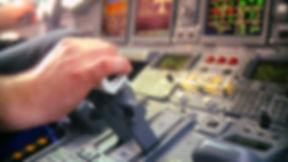
Commercial Pilot Program
A commercial pilot's license is one of the first steps taken by individuals that want to learn how to fly professionally. Having this license, means that you can be paid to pilot a plane carrying passengers or property.
To obtain a commercial pilot certificate or license, the FAA requires that he or she:
-
Be at least 18 years of age
-
Be able to read, write, and converse fluently in English
-
Hold at least a current third-class FAA medical certificate. Later, if your flying requires a commercial pilot certificate, you must hold a second-class medical certificate.
-
Hold at least a private pilot certificate with an instrument rating. A commercial pilot is presumed to have an instrument rating. If not, his/her commercial pilot certificate will be endorsed with a prohibition against carrying passengers for hire on day VFR flights beyond 50 NM or at night.
-
Receive and log ground training from an authorized instructor.
-
Pass a knowledge test with a score of 70 percent or better.
-
Accumulate appropriate flight experience and instruction. A total of 250 hours of flight time is required.
-
Successfully complete a practical (flight) test given as a final exam by an FAA inspector or designated pilot examiner and conducted as specified in the FAA's Commercial Pilot Practical Test Standards.
FAA's minimum aeronautical experience requirements for the Commercial Pilot certificate:
(a) For an airplane single-engine rating. Except as provided in paragraph (i) of this section, a person who applies for a commercial pilot certificate with an airplane category and single-engine class rating must log at least 250 hours of flight time as a pilot that consists of at least:
(1) 100 hours in powered aircraft, of which 50 hours must be in airplanes.
(2) 100 hours of pilot-in-command flight time, which includes at least -
(i) 50 hours in airplanes; and
(ii) 50 hours in cross-country flight of which at least 10 hours must be in airplanes.
(3) 20 hours of training on the areas of operation listed in § 61.127(b)(1) of this part that includes at least -
(i) Ten hours of instrument training using a view-limiting device including attitude instrument flying, partial panel skills, recovery from unusual flight attitudes, and intercepting and tracking navigational systems. Five hours of the 10 hours required on instrument training must be in a single engine airplane;
(ii) 10 hours of training in a complex airplane, a turbine-powered airplane, or a technically advanced airplane (TAA) that meets the requirements of paragraph (j) of this section, or any combination thereof. The airplane must be appropriate to land or sea for the rating sought;
(iii) One 2-hour cross country flight in a single engine airplane in daytime conditions that consists of a total straight-line distance of more than 100 nautical miles from the original point of departure;
(iv) One 2-hour cross country flight in a single engine airplane in nighttime conditions that consists of a total straight-line distance of more than 100 nautical miles from the original point of departure; and
(v) Three hours in a single-engine airplane with an authorized instructor in preparation for the practical test within the preceding 2 calendar months from the month of the test.
(4) Ten hours of solo flight time in a single engine airplane or 10 hours of flight time performing the duties of pilot in command in a single engine airplane with an authorized instructor on board (either of which may be credited towards the flight time requirement under paragraph (a)(2) of this section), on the areas of operation listed under § 61.127(b)(1) that include -
(i) One cross-country flight of not less than 300 nautical miles total distance, with landings at a minimum of three points, one of which is a straight-line distance of at least 250 nautical miles from the original departure point. However, if this requirement is being met in Hawaii, the longest segment need only have a straight-line distance of at least 150 nautical miles; and
(ii) 5 hours in night VFR conditions with 10 takeoffs and 10 landings (with each landing involving a flight in the traffic pattern) at an airport with an operating control tower.
Commercial Pilot Cost:
-
Aircraft rental: $205/hr. (Piper PA28R-201 Arrow ) Instruction: $60/hr.
-
For the commercial rating, up to 50 of the 250 total hours required can be flown in our full motion REDBIRD FMX simulator.
Email us for more information :
info@learntoflydc.com


